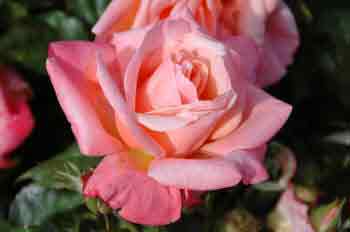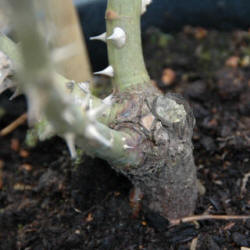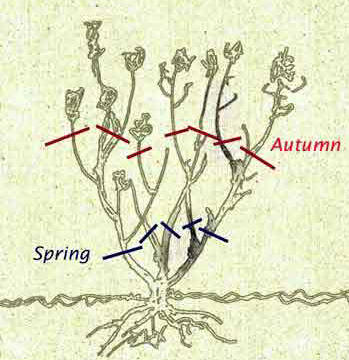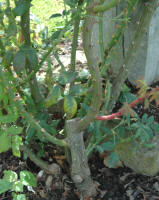

Silver Jubilee Rose
However, if you cannot get the sunlight to your roses, then get your roses to the sunlight. Simple enough as roses can be grown well in patio pots or other suitable containers.
Not all roses will grow permanently in containers, but many have been bred specially for that purpose. No longer do roses have to be grown in rose beds.
The only concern is trying to grow roses in the shade. Roses growing in the shade tend to end up with many problems, ranging from mildew to general malaise!
Most Roses need to be correctly pruned; well fed; See Feeding Roses and watered when dry. Organic feeds such as bonemeal or good well rotted mulches (See Mulching Roses) will do the trick, giving you healthy roses which are not as susceptible to some diseases suffered by sickly un-cared for specimens. (Sounds familiar?)
But of course, before all of that, you should plant your rose bushes with care and attention. This will tell you how to plant a rose bush.
Some of the modern roses - especially the new patio and miniature roses are easy to grow, and will add points of interest if strategically positioned.
Climbers and rambler roses can be grown up almost any structure that stays still - including trees, old garden sheds, pergolas, fences house walls. the list is endless for growing roses almost anywhere.
Roses can suffer from a multitude of pests and diseases - far more than any other group of shrubs - which include aphids (see Greenfly on Roses) blackspot (See Blackspot on Roses) mildew (Seee Mildew on Roses) and gardeners who cannot prune roses properly!
For greenfly and anything else on your rose that has legs, a simple course of insecticide will do the trick.
For mildew and black spot - both fungal diseases. Mildew can be arrested by a good rose fungicide, or better still a combined spray such as Roseclear. This will also kill bugs! Blackspot is a pain! You cannot 'cure' infected leaves. Pick them off and burn them.
In Rose Gardening - as with all other types of gardening, Prevention is best. Start spraying with combined spray from early summer. If you don't like sprays, then good husbandry goes a long way, until the blackspot appears. There are varieties which are resistant to blackspot - and also mildew. There are no varieties which are resistant to bugs!
Your choice of rose varieties has never been greater, and grows each year as the hybridists continue their patient, painstaking work to bring us suitable varieties - often with good descriptive, memorable names. talking of names, the list is growing, and we try to keep up to date to furnish you with lists of the rose names - for they make wonderful presents. Roses maybe associated with English gardens and even Englishness, but across the Atlantic in the US, rose growing is now almost as popular as it is in the UK and Europe.
As with most shrubs, roses can be bought and planted at any time of the year. They are available as bare root - or pre-packed- plants or in all manner of containers which should make for successful planting at any time of year.
The main criteria is the way they are normally grown and harvested by commercial growers. How and where to buy roses will help you decide. Most roses are grown in the open field and then dug up for sale or potting up in the early autumn. So with specific growing periods such as this, you will need to get your order placed for some of the popular varieties, instead of hoping to wander down to your garden centre in spring, hoping to find a particular variety.
Many of the choice varieties - especially climbers and standards, are pre-sold, and not available after lifting season in the autumn.
All of the nurseries have good descriptive catalogues - or web sites. So have a wander round, make your choice and get that order in to avoid disappointment.

Rose Root Stock
Most garden roses have been budded on to a vigorous rootstock system, which to all intents and purposes is not seen and is not generally visible as part of the plant.
The exception is if the rose was planted a little high in the soil, or if there has been some erosion of soil around the root system. In this case, a brown 'stub' can be seen at the bottom of the bush, protruding from the soil. (The rootstock is from one of the vigorous Briar type wild roses, and has no other purpose than to support the choice rose which is budded onto it.)

Prune Roses
So much mystique surrounds the subject of pruning rose bushes. There are so many experts on the subject, and of course when you get many experts you get many opinions! We show you how to prune Roses. Pruning roses is so simple, other than the fact that most rose bushes have thorns!
Firstly, lets answer the question "Why do roses actually need pruning?"

Pruning Ramblers
Ideally, you will be reading this because you have just bought a Rambling Rose and wish to know how to prune it. In reality, you probably have a very overgrown Rambling Rose that needs to be pruned. We will deal with the subject of pruning overgrown rambling roses first!
It might seem an impossible task in hand, and if very overgrown or neglected, will need a bit of willpower (and sturdy gloves).

Pruning Climbers
Before you attempt to prune your climbing rose, you have to be certain that it is a climbing and not a rambling rose type! A quick, more or less fail-proof test, is to ensure that your climbing rose has its leaves in groups of five leaflets.
Once you establish that you have Climbing Rose and not a Rambler, then follow the pruning advice below.